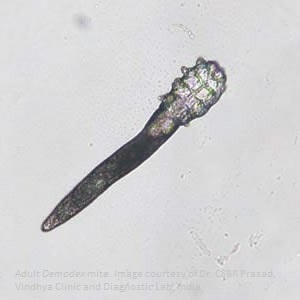 There’s a new theory in the acne world that we’ve all been foolish by focussing on bacteria. Instead we should be controlling infestations of demodex mites – tiny microbial insects that live in the skin of nearly every adult human.
There’s a new theory in the acne world that we’ve all been foolish by focussing on bacteria. Instead we should be controlling infestations of demodex mites – tiny microbial insects that live in the skin of nearly every adult human.
According to one alternative medicine website, 90% of teenage acne is triggered by demodex mites and only 10% is caused by bacteria. In books on Eastern European skincare you’ll find an abnormally large collection of advice on controlling these mites compared to elsewhere. In China there’s been an established and ongoing study of these parasites for 30 years now.
On the other hand, few pharmaceutical companies are making demodex killing acne creams or cleansers. They clearly wouldn’t ignore such a tremendous business opportunity – discovering the real cause of acne would make them billions. Likewise, in all my searching I’ve never found more than a handful of scientific studies on the subject.
What’s the truth about these microscopic insects? That’s what we’re going to find out today.
What are demodex mites?
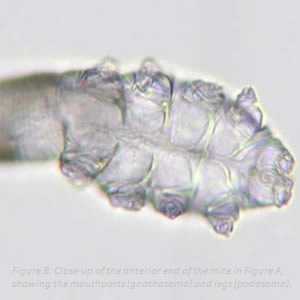 According to New Scientist, they are “tiny bugs closely related to spiders living in the pores of your face”. More specifically, demodex mites live in your hair follicles. You can’t see them, since they’re only 0.2mm long.
According to New Scientist, they are “tiny bugs closely related to spiders living in the pores of your face”. More specifically, demodex mites live in your hair follicles. You can’t see them, since they’re only 0.2mm long.
These things live for 2 weeks in total. It takes half a day for a female to lay her eggs (inside your hair follicles), two and a half days for them to hatch, and six days for a baby demodex mite to reach adulthood. From then on, a demodex mite will enjoy a further five days of life on your skin before exploding into a mass of proteins and falling into your pores.
Read Annihilate Your Acne – get the greatest diet ever for clear and radiant skin
Demodex mites might sound like a third world parasitic infection, but a third of all children, 50% of young adults, and two thirds of the elderly have them.
In the animal kingdom there are 48,500 species of mite, and the demodex family contains 65. Of those, only 2 reside on human skin – D.folliculorum and D.brevis.
Those two are our own special tribute from the demodex world as they are specifically adapted to live on human skin and no other animal. Other animals have their own specific species; the home-grown breed on dog skin is D.canis, cows have D.bovis, and rabbit skin is teeming with D.coniculi.
The key point is that in most animals, including humans, we live with these insects in peaceful harmony. In humans, they never cause serious illnesses like the worst water-borne parasites.
With that said, demodex mites do develop in many people from a minor colony to an infestation. 40% of adult humans have demodex mite infestations…
…and in patients where they have overgrown, they’ve been linked to all manner of inflammatory skin diseases like rosacea, dermatitis, and psoriasis. They’re being furiously investigated for their link to rosacea in particular.
It only seems logical that they could contribute to acne as well, and from the scientific explanations rebounding across the internet, I believe they can.
Claim 1 – dying demodex mites clog your pores up
The first theory is completely non-scientific but makes some sense. Just like p.acnes bacteria, demodex mites are obsessed with sebum and use it for food. When you have extremely oily skin, which most acne patients do, the previously small and controlled colonies of mites have a golden opportunity to feast and hence expand massively. This is one easy way through which infestations develop.
Next: the 6 vitamins and minerals which can massively reduce acne
The problem then is simple – the mites live for just twelve days, and when they inevitably die after a life of scuttling around on your skin, their dead bodies fall into your pores and block them. There’s so many that this adds to the sebum and dead skin cells already blocking the pores and makes your acne worse.
In my reckoning this is a plausible theory for sure, particularly since demodex mites are most highly concentrated in your hair follicles and pores.
Claim 2 – demodex mites trigger inflammation
 But with that said, there are far more viable explanations that connect demodex mites to acne. The first is the demodex mite’s extremely interesting way of dying. Once its short life is up a demodex might will basically explode and this leaks bacteria and proteins everywhere.
But with that said, there are far more viable explanations that connect demodex mites to acne. The first is the demodex mite’s extremely interesting way of dying. Once its short life is up a demodex might will basically explode and this leaks bacteria and proteins everywhere.
P.acnes bacteria is what stimulates an immune system response in any acne patient that ultimately leads to a big red pimple, but there are many other forms of bacteria that can also receive a response. Strains from a common parasite like this would almost certainly be targeted.
There’s also a theory that demodex mites carry bacteria while they’re living and deposit it in your skin pores. If correct, that would further pile on the immune system targets in any p.acnes overgrowth.
The 7 greatest topical treatments for naturally clear skin
Finally, their death spills a lot toxic proteins on to the surface of your skin. Given that human skin produces an inflammatory response against all sorts of other proteins, bacteria, and oxidised compounds, it’s highly plausible that these foreign molecules also trigger a big immune system attack.
There’s plenty of evidence for this inflammation theory in the studies conducted on other skin conditions. Rosacea, for instance, is the acne-lookalike condition where your skin gets red and shiny, but not necessarily spotty. Its real name is acne rosacea but it’s not acne at all. Blocked pores and bacterial infections are not involved – instead, rosacea is a classic inflammatory condition:
STUDY ONE – this study analysed the skin composition of patients with rosacea and found substantially increased levels of cathelicidin. That’s a peptide with various effects which most importantly, triggers the production of a highly inflammatory immune chemical called interleukin-8.
STUDY TWO – this review published in the Journal of Drugs in Dermatology in 2012 reviewed all of the evidence and concluded that “the major presentations of rosacea appear to be inflammatory dermatoses”. They also revealed that nearly all available therapies designed to treat rosacea were anti-inflammatory in nature.
Clearly, rosacea is a disease characterised by high amounts of inflammatory chemicals in the skin.
STUDY THREE – Next we have this study in which scientists performed a skin biopsy on 94 patients: 49 with rosacea, and 45 control subjects. The amount of demodex mites per square centimetre of skin was analysed in all patients.
The difference was colossal. Controls had an average of 0.7 mites per square centimetre of skin, whereas the rosacea patients had an average of 12.8 mites.
STUDY FOUR – then there’s this review of 48 different rosacea studies in both Chinese and English, which covered 10 countries and over 28,000 participants.
Why bread and pasta are a massive cause of acne
In the mix of a lot of technical data there was one big statistic: patients with rosacea were 8 times more likely to have a demodex mite infestation. The reviewers concluded that “A significant association exists between Demodex infestation and the development of rosacea”.
Rosacea is also a disease characterised by high amounts of demodex mites in the skin.
Is there a link? The evidence is nowhere near conclusive, but there’s a good chance that the demodex mites were responsible for all that inflammation. Moreover, there are many other studies showing that mite infested pores have higher levels of inflammatory chemicals.
Hence they’d also be a nightmare for acne, because systemic inflammatory chemical overload can worsen the appearance of all your pimples. It can redden them, swell them, and make them painful, and stimulate your immune system to create new ones in the first place.
Claim 3 – mite killing drugs can work miracles
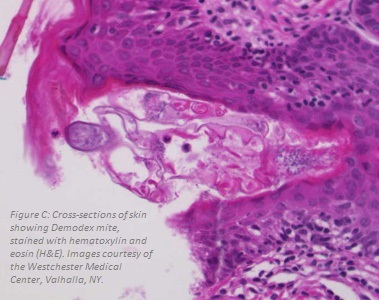 Demodex mites are laughed at by many acne patients. But if you perform a basic search on google, you’ll actually find a ton of good stories where people improve their skin conditions by killing them. I’ve read stories where demodex killing creams…
Demodex mites are laughed at by many acne patients. But if you perform a basic search on google, you’ll actually find a ton of good stories where people improve their skin conditions by killing them. I’ve read stories where demodex killing creams…
-Wiped out pimples 100%.
-Massively reduced sebum plugs.
-Substantially reduced “oozing” spots like whiteheads.
-Evened out the skin tone excellently.
Usually, the patients notice a worsening of their skin for a couple of weeks and attributed this to the existing demodex mites dying off and filling your pores. But many claim that after four weeks of daily treatment, the conveyor belt of new pimples ground to a near halt. The testimonials fit well with the science we know as well in terms of the lowered inflammation and time it took for effects to appear.
You should never fully rely on testimonials when making recommendations. Firstly, cosmetic companies are known to plant reviews on pages to get the score up and suck the customers in. Secondly, patients often hope for miracle cures and get overly enthusiastic when they notice a small benefit.
However, there are also clinical studies on drugs designed to kill the mites. One study on papulopustular rosacea patients applied a 5% solution of permethrin, a demodex mite killing cream. The following reduction in rosacea symptoms was equally as impressive as the results from conventional rosacea drugs.
Important knowledge – why common vegetable oils are pure evil for acne
There’s also a study mentioned in this review paper from 2012 which is unfortunately written in Chinese. It reportedly analysed 100 dermodicidosis patients with symptoms similar to acne and treated all of them with mite-killing essential oils.
After 6 weeks, demodex mite numbers fell by 90% and the number of inflammatory skin lesions fell by 80%. That one in particular demonstrates a clear link between demodex mites and skin conditions.
Studies on demodex mites and acne
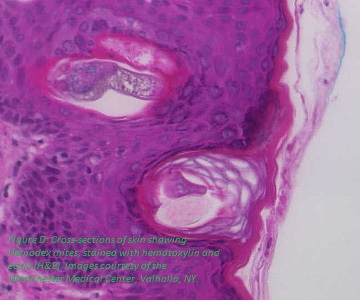 Now we have the moment of truth. Acne vulgaris is similar to rosacea and other inflammatory skin conditions like dermatitis and psoriasis (both of which are connected to demodex mites) but acne is far more connected to high sebum production and blocked pores, so identical results are not guaranteed.
Now we have the moment of truth. Acne vulgaris is similar to rosacea and other inflammatory skin conditions like dermatitis and psoriasis (both of which are connected to demodex mites) but acne is far more connected to high sebum production and blocked pores, so identical results are not guaranteed.
There’s only a handful of studies available, but this meta-analysis from 2012 analysed the acne-demodex mite question in detail. It looked at many Chinese studies and found that…
- The demodex mite infestation rate in acne patients was 51.85%, but only 31.54% in clear-skinned controls.
- Demodex mites were 2.8 times more abundant in acne patients compared to clear-skinned controls.
Those results are certainly impressive, but they’re nothing compared to those for rosacea patients where they had 15 times more demodex mites per square centimetre. The infestation rates are higher, but as the study shows, a substantial amount of healthy patients also had infestations.
Even if acne patients have more, it doesn’t mean that they cause pimples. Acne patients almost always have high sebum production, three times as much as clear-skinned people on average. Mites feed off of sebum and use it to expand their colonies, so the demodex mite overgrowth could easily be caused by the same factors that cause acne, rather than a cause itself.
Do demodex mites cause acne?
Here’s my conclusion on the matter. I don’t believe that demodex mites are the hidden root cause of acne lurking under everybody’s nose. Correlation does not equal causation. Out of all the common inflammatory skin conditions, acne has the weakest plausible link to demodex mite infestations.
Even if demodex mites were the main topical condition behind acne, even if they were a bigger villain than p.acnes bacteria, I still wouldn’t recommend you make them public enemy number one. Diet and lifestyle are the real cause of acne, not hygiene.
What is likely is that these parasites can contribute some additional inflammation on top of the damage already wrought by the bigger acne villains like bacteria. Whether it’s from the mites blowing up and spewing inflammatory proteins everywhere or whether they’re up to something else we don’t know about is unclear. What’s certain is that psoriasis, dermatitis and rosacea are strongly inflammatory skin conditions and in turn, they are strongly linked to demodex mite infestations.
With that said though, tackling the problem is unnecessary. The truth is that demodex mites should not affect your acne strategy in any way.
Here are my recommendations. Instead of wasting time with a topical treatment like tea tree oil or permethrin, you should focus 50% on reducing your sebum production and 50% on lowering inflammation.
If you optimise your hormones, get plenty of vitamin A (which is the best vitamin ever for oily skin), get zinc to enhance that vitamin A, and eat a generally nutritious diet, your sebum production will fall substantially regardless of your genetics.
Vitamin D – the greatest nutrient for a bright and glowing skin tone
When it does, the demodex civilisation on your face will enter crisis mode. They will be starved of the food they need to take over. You will have prevented the problem and you won’t have to waste time looking in the mirror and applying creams to your face every morning.
What’s even more important to understand is that I don’t recommend fussing over topical treatments anyway. Both demodex mites and p.acnes bacteria, the main target of BP and other acne creams, will be taken care by creating a healthy diet. With demodex mites, you take away the sebum; with p.acnes bacteria you unblock your pores. When it comes to treating acne, it’s always smarter to treat the root causes rather than the symptoms.
Demodex mites infestation are only able to happen because of much wider problems in your body and it’s those problems that you need to tackle, whether it’s chronic inflammation, free radical overload, environmental chemical exposure in make-up and shampoo, or nutritional deficiencies. When you do tackle them, demodex mites will automatically retreat.
Treat the problems behind acne, not the symptoms! Topical treatments are there as a bonus, and to that end, grapeseed oil and sea buckthorn oil are two of the best.
Demodex mites do cause acne but for those reasons, they don’t need to enter your brain for a minute.
The best demodex mite treatments
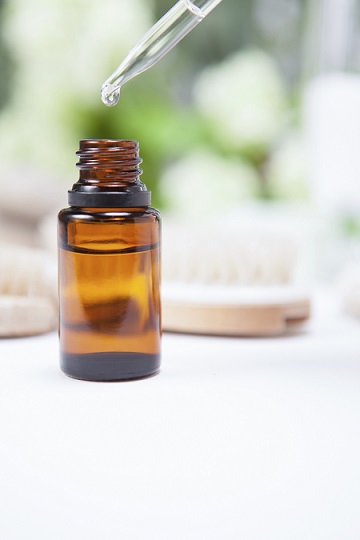 The only instance in which killing demodex mites will improve your skin miraculously is if your acne happens to be especially caused by them. If that’s the case, lowering sebum production will still work well. However, if your acne takes a while to recover, then the mites are probably slowly dying off but not quickly enough.
The only instance in which killing demodex mites will improve your skin miraculously is if your acne happens to be especially caused by them. If that’s the case, lowering sebum production will still work well. However, if your acne takes a while to recover, then the mites are probably slowly dying off but not quickly enough.
That’s a circumstance in which tea tree oil would be useful; for killing off the remaining mites extra quickly. Tea tree oil is great for killing p.acnes as well thanks to its antibacterial terpinen 4-ol compound and it’s widely acknowledged as the safest natural weapon against mites:
- One study used 50% tea tree oil against demodex mites, and while they came back after usage ended, TTO was noted to kill them quickly. Scientists commented that the mites started fleeing the skin.
- A combination of 50% tea tree oil and a 5% shampoo weekly wiped out the infestations forever. The mite count fell to zero in some patients.
- Another study found that 5% tea tree oil was just as effective, so there’s no need to buy super-strong solutions.
Of course, if after reading this you later discover that your skin condition is actually rosacea or dermatitis, or if you have them now on top of your acne, then tea tree oil is your prime choice. Dill weed and caraway oil are just as effective at killing the mites, but they also have side effects like burning, irritation and reddening. There isn’t any reason to use them.
If you want to experiment then you could also try tea tree oil but other than that, demodex mites will be reduced automatically by acne strategies you should be following anyway.
Conclusion
Demodex mites almost certainly add some additional inflammation to your skin, but for the average acne patient they’re not worth dedicating time, money and effort towards. The most you might want to do is use tea tree oil, to take out both p.acnes and the mites at the same time.
Finally, there’s an important message in all this that can apply to anything you read about health. It seems horrific at first that these creates are living it up and having the time of their lives on your skin. Demodex mites even have sex while they’re there. Apparently their favourite spot is the outer rim of your hair follicles…
…but while any such creature might make you reach for a chemical facial cleanser, understand this – every human being is housing a whole planet’s worth of microbial life. You’re only 10% human – 100 trillion cells in your body are bacteria. They inhabit everywhere; your gut, your skin, your hair…
Furthermore, many can actually clear your skin. Increasing healthy strains of gut bacteria is one of the best acne strategies. It can lower inflammation, boost serotonin production, improve acne nutrient digestion and much more.
So don’t fear every so called creepy-crawly, because many are great for your health.
NEXT: the ultimate diet for clearing acne permanently
Thanks for reading!
The information was helpful thank you.
Its true start from your gut.
I suffer from acne since I was 18now I’m 27it goes away and comes back. My doc has me on doxycycline hyclate 100mg a day. And retin-a.. Topical cream. But I was dogs inside my house a medium dog and two small ones could mites me on my face because seems like every time I look, I have a mite spot on my leg or hip where they sit. Next too me. And the last few days I have it on my face bad. The topical cream isn’t helping or doxycycline hyclate.. :(…. I also have proactive plus. I use daily, and I attended red light therapy sessions for three months now. Still am going to those.. I also wanted to know. Since when I use oily base things I too get acne in like few hours would tea tree oil be fine for my skin. I’m fair skinned and sensitive to everything.
Tea tree oil can be harsh on some people, but it’s worth a try. A much gentler treatment (and extremely effective one) is raw honey, so you can try that too. Read the article on honey here. If you’re fair skinned and sensitive to everything though, it sounds like you should make eating an acne-friendly diet your top priority. You can start by reading this article: https://supernaturalacnetreatment.com/real-causes-of-acne/
I eat a whole plant based diet, drink loads of water, meditate and do yoga. I am 40 and still the acne persists. Also, I would like to add that I have chronically dry skin. I am about to dust diatomaceous earth over my face in a bid to kill the mites, if they exist.
While I agree that diet plays a huge role in the health of skin, I could not be any healthier and it’s not helping.
A plant based diet is not ideal for acne though. You probably lack minerals such as zinc and selenium unless you supplement with them or eat Brazil nuts.
I have found great releif from what doctors call bleach baths. Research, try them. I love them now. About a fouth of a cup per gallon of water to start, Do a foot bath first. You will be amazed. I make it stronger. The floral smelling bleach makes a bath more pleasant. I also really like essential oils. They aren’t like other oils, don’t worry. Try them, you will see what people mean. There are a ton, but tea tree is most effective. Lavender essential oil is wonderful. I too am working on restoring my good gut bacteria. Stay away from antibiotics, and get an allergy test. The allergy test and elimination diet have been helpful in solving my inflammation issues. That and a washing machine that has water temperature above 125 degrees Fahrenheit. I am allergic to dust mites. Lots of people are.